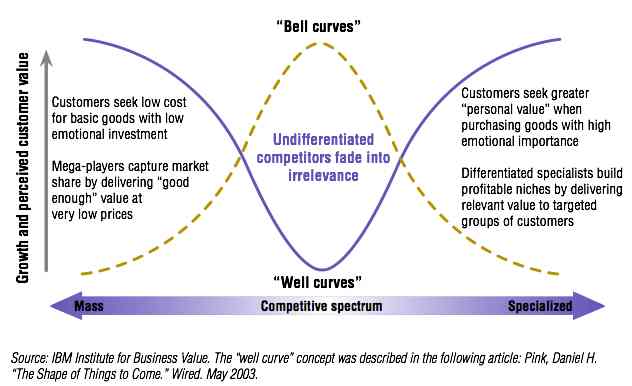I stumbled across this through an IBM white paper on consumer trends. The "Well Curve" is a term, coined by Daniel Pink at Wired Magazine, describing an inverted bell-shape, where people are expressing preferences in either affordable mass-products on one side of the spectrum, and on the other side, demand for luxury products which possess emotional qualities to the consumer. The companies that fall in between suffer from a lack of identity and demand. This phenomenon can also be observed in politics and the way organisations structure themselves. 
This demand-curve is stimulated by a number of trends, made clear in the white paper. On the demand-side you can see that:
- Customers have access to virtually an unlimited* amount of information
- Customer values are fragmented and drive fragmentation in markets
- Customers become more guarded about how their privacy / personal data is used*, which requires changing marketing strategies
And on the supply-side, you can see that:
- Megaretailers are "expanding across geographies, formats and product/service categories, blurring market segments and devouring market share."
- Companies are forming flexible “value networks,” which offer more value to consumers are hard to replicate.
What about emotional quality at emotional prices (my emotions definitely prefer low prices)? While this sounds like a joke, I'm completely serious about it. The reason why marketeers don't like emotions, is because they seem very hard to measure. Instead, replace the word by 'individualistic.' Individualistic quality at individualistic pricing. The curve, which right now is 2-dimensional, would then have to be shifted to represent a number of overlaying curves, sort of like waves in an ocean, representing all the individual demand-curves that are possible. I suppose, I could coin it the "Wave curve."
To an extent, you can see this being played out in some business models that have come forward in online music. Radiohead just released their latest album "In Rainbows," at a price which downloaders can decide. Similarly, the Freakonomics-blog describes the phenomenon, as they do in their book, in regards to bagels.
Of course, this can also be viewed as one part of a greater selling-strategy. "In Rainbows" may be selling online at emotional prices, but at lower-than-cd quality. At the same time, Radiohead are also selling cds, which are claimed to contain extra content, as well as selling out at concerts (a true example of emotional value at high prices). So not much has changed there.
An alternative model would the auction-method, though I think that this only works if there is a restricted supply, made possible with rare goods or airplane-seats, but not so much goods that can easily be mass-produced.
It's hard to predict whether a wave-type curve would work as a viable revenue-model, but what is clear is that when you give consumers a real choice, they will choose more than one or two variables, instead maybe ten or twenty. And I suppose that the next best solution for that is simply the free market.
Filed under: business strategy, customers, Globalisation, innovation, marketing, Research, retail, suppliers, technology, tools, trends

This demand-curve is stimulated by a number of trends, made clear in the white paper. On the demand-side you can see that:
- Customers have access to virtually an unlimited* amount of information
- Customer values are fragmented and drive fragmentation in markets
- Customers become more guarded about how their privacy / personal data is used*, which requires changing marketing strategies
And on the supply-side, you can see that:
- Megaretailers are "expanding across geographies, formats and product/service categories, blurring market segments and devouring market share."
- Companies are forming flexible “value networks,” which offer more value to consumers are hard to replicate.
What about emotional quality at emotional prices (my emotions definitely prefer low prices)? While this sounds like a joke, I'm completely serious about it. The reason why marketeers don't like emotions, is because they seem very hard to measure. Instead, replace the word by 'individualistic.' Individualistic quality at individualistic pricing. The curve, which right now is 2-dimensional, would then have to be shifted to represent a number of overlaying curves, sort of like waves in an ocean, representing all the individual demand-curves that are possible. I suppose, I could coin it the "Wave curve."
To an extent, you can see this being played out in some business models that have come forward in online music. Radiohead just released their latest album "In Rainbows," at a price which downloaders can decide. Similarly, the Freakonomics-blog describes the phenomenon, as they do in their book, in regards to bagels.
Of course, this can also be viewed as one part of a greater selling-strategy. "In Rainbows" may be selling online at emotional prices, but at lower-than-cd quality. At the same time, Radiohead are also selling cds, which are claimed to contain extra content, as well as selling out at concerts (a true example of emotional value at high prices). So not much has changed there.
An alternative model would the auction-method, though I think that this only works if there is a restricted supply, made possible with rare goods or airplane-seats, but not so much goods that can easily be mass-produced.
It's hard to predict whether a wave-type curve would work as a viable revenue-model, but what is clear is that when you give consumers a real choice, they will choose more than one or two variables, instead maybe ten or twenty. And I suppose that the next best solution for that is simply the free market.
 The
The 

